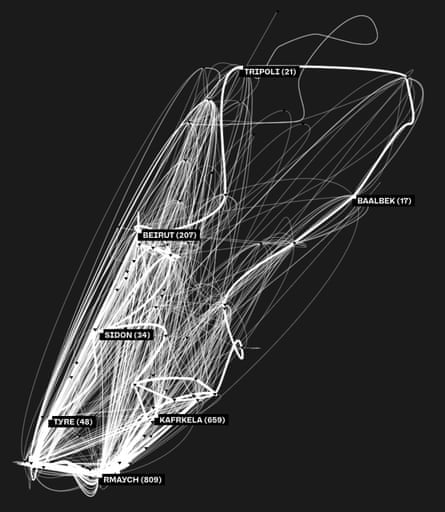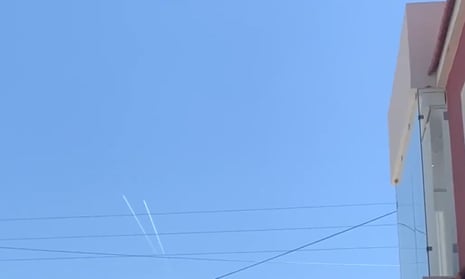For decades, the roar of Israeli jets, and the hum of surveillance drones have been regular features in the skies above Lebanon, buzzing towns and cities at will – and acting as constant reminders that war is never far away.
Research, which was published on Thursday, demonstrates just how pervasive that presence has been, with at least 22,000 overflights being documented in the past 15 years alone. Those numbers have made warplanes an abiding soundtrack to Lebanese life and the ever present threat of violence a part of the country’s collective psychology.
Produced by a new organisation, AirPressure.info, the research shows Israeli planes have occupied the skies of Lebanon for a total of eight and a half of the past 15 years. Few of the incursions are brief, with many lasting an average of four hours and 35 minutes. And most involve the most technically advanced fighter planes or surveillance aircraft in the world that basic Lebanese ground defences offer no match for.

Maps of the flight routes taken by the jets and drones reveal a spaghetti bowl of loops over most areas of Lebanon. The flights are concentrated in the south, where they appear to follow set routes. But Beirut is also a frequent destination, as are areas north of the capital and closer to the Syrian border.
Lawrence Abu Hamdan, who assembled the research, which is the most comprehensive of its kind, said studies had shown regular exposure to overflights by warplanes had taken a toll on those living below. AirPressure.info has compiled 11 peer-reviewed papers from scientific journals that detail the acute physiological effects of aircraft noise, with symptoms ranging from hypertension to diminished blood circulation and psychosomatic pains.
Perhaps less understood is the psychological effect of foreign warplanes dominating the skies above a civilian population. They often fly at low altitudes that cause alarm and panic.
“While in Lebanon, each one of these acts is felt as a briefly passing moment and no two residents may hear jets in the same way or at the same time,” said Abu Hamdan. “What I aim to present is an accumulated event, one extended crime that has taken place over the past 15 years.
“But really this should be seen as an atmosphere of violence. It takes its toll over time, and that’s why it has the potential to be ignored, but it shouldn’t be ignored any longer. Why should a population live under mass indiscriminate surveillance and live under a hostile sky … to the extent that it’s embodied into everyday life.”
The numbers have been compiled from 243 letters addressed by Lebanon to the UN security council, which were often informed by data supplied by the UN interim force in Lebanon, a peacekeeping mission, and by the Lebanese army.
In addition, over the past two years researchers were hired to survey the skies and chronicle images of Israeli aircraft. “These videos capture the threatening sounds and sights of Israeli military aircraft, as well as the discussion among citizens and residents speaking about what’s happening above them,” said Abu Hamdan.
Israel has long maintained that its intrusions over Lebanon are necessary to gain intelligence of Hezbollah, the militia-cum political bloc that holds sway over most political decisions in the country and outguns the national army. It has also used Lebanese skies to bomb targets in Syria linked to Iran, the key backer of Hezbollah.
The Israeli air force has some of the most powerful surveillance capabilities in the world, and fears that civilian communications are regularly intercepted by Israel’s eavesdropping planes have been regularly raised.
Lebanon and Israel have technically remained at war since the end of decades of civil war and the Israeli withdrawal from south Lebanon in 2000. The last protracted spate of violence was a month-long war between Hezbollah and Israel in the summer of 2006.
